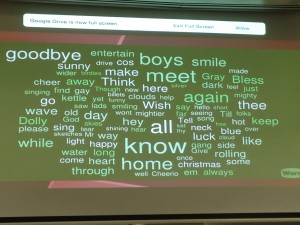For this week’s reading, we explored the notion of collaboration and enabling conditions that contribute to flow and heightened consciousness within a group.
According to Keith Sawyer, there are 10 enabling conditions that contribute to flow (2007) and, as this notion resonated with me, I thought I’d investigate these 10 points in relation to my experiences.
How could these points be contextualised?
My preterition of specifics in these examples is very deliberate as certain issues may still be in contention.
1 The group’s goal – I had conceptualised a band in 2004 and had few people to work with. Through several audition sessions, I eventually decided on the troupe that I would later work with. However, it eventually became apartment that everyone had different goals and inevitably the group dissolved.
2 Close listening – Is total engagement, blocking out everything that is superfluous to the task. We do this in acting by spending prolonged periods of time before a performance engaging in sensory visualisation and relaxation.
3 Complete concentration – In music, a progression change in a song can be led by an individual. Every member should be fully engrossed in their task however, it is important that they keep an ear out for the cues that lead the group into the next part of the progression.
4 Being in control – (Being granted autonomy) In a workplace where I was granted permissions to recruit, train and coach staff autonomously resulted in an efficient and positive team. However, a friend of mine has experienced the opposite whereby the figure in charge micromanages tasks, putting their own mark on my friends work causing frustration and a blockage in the flow.
5 Blending Egos – Skyhooks front man Shirley Strachan said in the 1975 hit album, ‘Ego Is Not a Dirty Word’… and it’s true! Everybody has one but it is not necessarily about big hair, vanity and tight trousers; it is a force that drives humans toward a goal. So when egos blend with the right chemistry & balance, it can result in a powerful collaboration. Having worked in several scenarios where egos were miss-matched, I had become lucidly aware of the importance of ‘blend’; therefore, now when selecting people to work with, not only do I look for talent and poise but I also ensure there is a mutual respect for ideas.
6 Equal Participation – (Personal destruction of a group) An organisation that I had been a part of experienced issues where some staff, despite having the same ranking, were favoured over others giving a large portion less privileges intern causing friction, hindering overall flow and ultimately leading to attrition.
7 Familiarity – (With the craft and each other) Within my course at RMIT, I am slowly learning the language of how things work thus I am understanding how to engage better with fellow students and teachers and the like.
8 Communication – In my current position, I had made a pact with my boss that, in light of my varying situation with uni and family, I would keep him informed of any changes as they arise. This agreement is beneficial for both parties as my boss will be able to plan better and I feel that the company has my back so to speak.
9 Moving it forward – (Keep moving the conversation – listen closely – accept fully – extend and build) An esteemed friend of mine is a talented singer song writer who recently asked me to collaborate on one of her projects. I was of course much obliged and relished the opportunity. The elements to her success were quickly made apparent when, in a creative, brainstorming conversation, nothing was out of the realms of possibility. Any idea put forward by members of the group… no matter how absurd, would be considered. She would listen intensely and respond with, “Let’s go with that and see where it takes us”. The ideas flowed freely and the sessions were brimming with positive morale.
10 The potential for failure – (Prepare) In theatre, we thoroughly explore all the possible things that could go wrong; the most common would be forgetting one’s lines or cues. In this situation an actor should be trained to improvise as close to the intention of the script as possible; however, when I was singing with an orchestra in 2002, I became so nervous that I came in 4 bars too early; I was singing 4 bars in front of the orchestra! As it was highly unlikely that the orchestra was going to improvise around my mistake, I had to engage in 4 bars of humming, scatting and la-la-la-ing to allow for the orchestra to catch up. I almost instantaneously became a better musician as I vowed to never let that happen again. This experience has definitely contributed to my heightened awareness. My failures have nearly always resulted in an essential learning experienced that are frequently referred to when working in a group setting.




